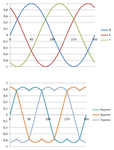Akshaydpal
Member level 1

what will be the rms out put voltage of an inverter if the input is 240v DC?
how much input is required in DC to get a 240V AC rms output ?
how much input is required in DC to get a 240V AC rms output ?


